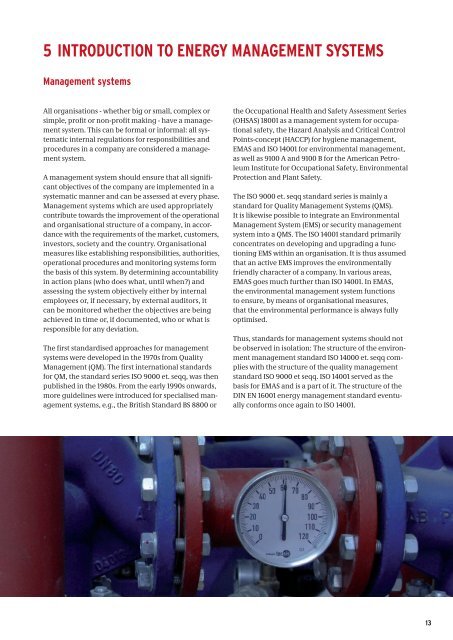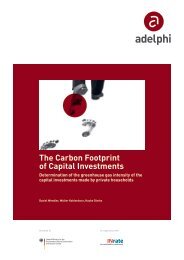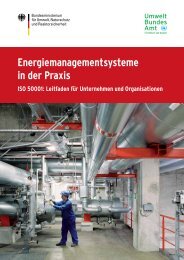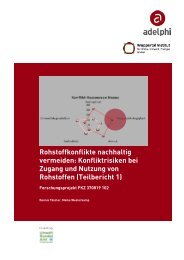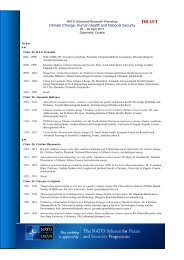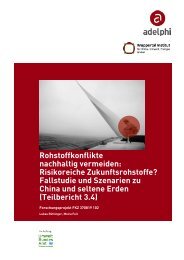DIN EN 16001: Energy Management Systems in Practice - adelphi
DIN EN 16001: Energy Management Systems in Practice - adelphi
DIN EN 16001: Energy Management Systems in Practice - adelphi
Create successful ePaper yourself
Turn your PDF publications into a flip-book with our unique Google optimized e-Paper software.
5 INtRODuCtION tO <strong>EN</strong>ERGy MANAGEM<strong>EN</strong>t SyStEMS<br />
<strong>Management</strong> systems<br />
All organisations - whether big or small, complex or<br />
simple, profit or non-profit mak<strong>in</strong>g - have a management<br />
system. This can be formal or <strong>in</strong>formal: all systematic<br />
<strong>in</strong>ternal regulations for responsibilities and<br />
procedures <strong>in</strong> a company are considered a management<br />
system.<br />
A management system should ensure that all significant<br />
objectives of the company are implemented <strong>in</strong> a<br />
systematic manner and can be assessed at every phase.<br />
<strong>Management</strong> systems which are used appropriately<br />
contribute towards the improvement of the operational<br />
and organisational structure of a company, <strong>in</strong> accordance<br />
with the requirements of the market, customers,<br />
<strong>in</strong>vestors, society and the country. Organisational<br />
measures like establish<strong>in</strong>g responsibilities, authorities,<br />
operational procedures and monitor<strong>in</strong>g systems form<br />
the basis of this system. By determ<strong>in</strong><strong>in</strong>g accountability<br />
<strong>in</strong> action plans (who does what, until when?) and<br />
assess<strong>in</strong>g the system objectively either by <strong>in</strong>ternal<br />
employees or, if necessary, by external auditors, it<br />
can be monitored whether the objectives are be<strong>in</strong>g<br />
achieved <strong>in</strong> time or, if documented, who or what is<br />
responsible for any deviation.<br />
The first standardised approaches for management<br />
systems were developed <strong>in</strong> the 1970s from Quality<br />
<strong>Management</strong> (QM). The first <strong>in</strong>ternational standards<br />
for QM, the standard series ISO 9000 et. seqq, was then<br />
published <strong>in</strong> the 1980s. From the early 1990s onwards,<br />
more guidel<strong>in</strong>es were <strong>in</strong>troduced for specialised management<br />
systems, e.g., the British Standard BS 8800 or<br />
the Occupational Health and Safety Assessment Series<br />
(OHSAS) 18001 as a management system for occupational<br />
safety, the Hazard Analysis and Critical Control<br />
Po<strong>in</strong>ts-concept (HACCP) for hygiene management,<br />
EMAS and ISO 14001 for environmental management,<br />
as well as 9100 A and 9100 B for the American Petroleum<br />
Institute for Occupational Safety, Environmental<br />
Protection and Plant Safety.<br />
The ISO 9000 et. seqq standard series is ma<strong>in</strong>ly a<br />
standard for Quality <strong>Management</strong> <strong>Systems</strong> (QMS).<br />
It is likewise possible to <strong>in</strong>tegrate an Environmental<br />
<strong>Management</strong> System (EMS) or security management<br />
system <strong>in</strong>to a QMS. The ISO 14001 standard primarily<br />
concentrates on develop<strong>in</strong>g and upgrad<strong>in</strong>g a function<strong>in</strong>g<br />
EMS with<strong>in</strong> an organisation. It is thus assumed<br />
that an active EMS improves the environmentally<br />
friendly character of a company. In various areas,<br />
EMAS goes much further than ISO 14001. In EMAS,<br />
the environmental management system functions<br />
to ensure, by means of organisational measures,<br />
that the environmental performance is always fully<br />
optimised.<br />
Thus, standards for management systems should not<br />
be observed <strong>in</strong> isolation: The structure of the environment<br />
management standard ISO 14000 et. seqq complies<br />
with the structure of the quality management<br />
standard ISO 9000 et seqq. ISO 14001 served as the<br />
basis for EMAS and is a part of it. The structure of the<br />
<strong>DIN</strong> <strong>EN</strong> <strong>16001</strong> energy management standard eventually<br />
conforms once aga<strong>in</strong> to ISO 14001.<br />
13


